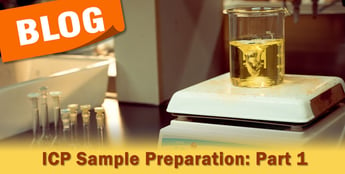
A majority of samples analyzed by Inductively Coupled Plasma Optical Emission Spectroscopy (ICP-OES) are introduced to the instrument as solutions. Sample preparation for analysis by ICP-OES may be as simple as filtering and adding acid to a liquid sample or be a lengthy, complex procedure to dissolve a solid. In order to obtain the best possible analytical results, an appropriate technique must be used to convert the sample into a usable solution. Part 1 and 2 of this blog will briefly examine some of the more commonly used sample preparation techniques, and highlight their respective advantages and disadvantages.
Wet Digestion
Wet digestion is the most common method used to dissolve solid samples. This technique has been in use for over 100 years and is a well-established methodology. Typically, a wet digestion is carried out on a hot plate in a borosilicate or PTFE vessel using one (or a mixture) of the common mineral acids (HNO3, HCl, H2SO4, HF).
Advantages of Wet Digestion
This technique has a number of advantages associated with it.
- Generally speaking wet digestion is a very simple procedure and applicable to a wide variety of sample types.
- The technique allows a relatively large amount of sample to be dissolved. This can be an advantage particularly when elements are to be determined at the trace level.
- The hot plates and beakers required are relatively inexpensive.
- The use of PTFE beakers vastly reduces the possibility of trace metal contamination leaching into the sample.
- Adding reagents to the sample vessels is easily accomplished.
Disadvantages of Wet Digestion
-
Though an extremely useful way to “open out” a sample, this technique is not without shortcomings:
- Wet digestion can take minutes, hours or even days. The maximum sample temperature that can be reached in a digestion is determined by the boiling point of the acid used. Since the sample is being heated by conduction, only a very small portion is at the temperature of the heat being applied to the vessel. Also, upon heating, acids can lose strength.
- Volatile elements can be lost. For example, Si and B can be lost when HF acid is used. Similarly As, Sb, Sn and to some extent Se and Te can be lost when using HCl acid solutions.
- Violently reacting solutions risk losing sample by spattering. Consequently, the digestion procedure must be monitored closely.
- Evaporation causes the concentration of impurities as the digestion progresses.
- Large amounts of acids may be required, potentially raising blank levels. Some acids such as HClO4 and HF can be hazardous.
- Contamination from borosilicate containers and external sources is possible.
- The evolved acid fumes are corrosive.
Pressure (Bomb) Digestion
Pressure digestion is essentially the wet digestion technique carried out under pressure. Samples are placed in a PTFE lined, steel jacketed container. The assembly is then be placed in a heated laboratory oven.
Advantages of Pressure Digestion
Pressure digestion addresses some of the disadvantages of the wet digestion, making it the method of choice for certain sample types:
- Digestion can be much faster than open vessel wet digestion.
- Sealed containers permit the digestion to occur at much higher temperatures and pressures. Consequently, the digestion of much more difficult samples can be performed (e.g., silicate rocks). Acids will not lose strength, nor will their concentration be reduced through evaporation.
- The higher temperature and pressure allow the use of less concentrated acids, minimizing contamination.
- The loss of volatile metals and the opportunity for external sample contamination is virtually eliminated.
- Leaching of trace elements from the PTFE liners is extremely low.
- Constant monitoring is unnecessary.
Disdvantages of Pressure Digestion
While a useful technique, pressure digestion has some disadvantages that prevent it from being more routinely used:
- The digestions can be very slow.
- The size of the sample to be digested is limited to a few tenths of a gram. This can be a problem when trace levels must be determined. Large amounts of sample, particularly those high in organic material, can result in an explosion or loss of sample through pressure release.
- During long digestions, it is possible for trace elements to diffuse into the PTFE liner.
- Assembly and cleaning of the pressure container can be tedious.
- Pressure container assemblies are expensive.
For more information on Teledyne Leeman Labs and ICP-OES, please visit our website or contact us by clicking on the button below

